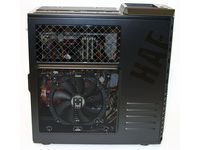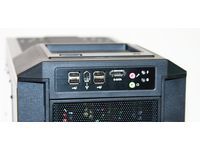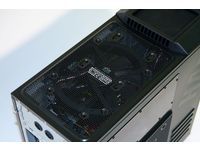Four Full Tower Cases From $150 To $600
Cooler Master HAF 932--Unpacking And Build
$159

Unpacking
Getting Cooler Master’s HAF (High Air Flow) 932 out of its box was a piece of cake—the Styrofoam protecting it was thin and brittle, so it easily broke away. Nevertheless, the chassis itself was intact and undamaged.
Inside the case, Cooler Master includes a well-illustrated instruction manual that should simplify setup for gamers unaccustomed to piecing together their own hardware. Also inside the HAF’s packaging is a generously-large bundle of screws, standoffs, and zip ties, a 5.25” bay adapter for 3.5” devices, and a complete caster set. There’s an 8-pin extension cord, too, for power supplies with an auxiliary +12V lead that’s just not able to reach your motherboard. Given the HAF’s power supply placement at the bottom of the case, this is a very smart inclusion.

Once everything’s unpacked, you’re ready to start installing. Cooler Master ties off its front panel connectors, headers, and eSATA cable to keep them out of your way, resulting in a very clean interior.
Build
Upon pulling off the HAF’s plastic bag, it quickly became clear that the chassis doesn’t offer much in the way of acoustic insulation, as most of its top, most of its left-hand side, most of its front, and much of its backside is riddled with ventilation holes. No doubt this is because Cooler Master isn’t worried about its own fans creating much of a racket. There’s a massive 230 mm cooler under the top cover, spinning at 700 RPM and generating 19 dBA, according to Cooler Master. There’s a second 230 mm fan inside the left side panel, a 230 mm LED fan inside the front panel, and a 140 mm fan in the back. The idea is that the HAF moves a massive amount of air without creating much in the way of noise pollution—so long as the components inside the case aren’t exorbitantly loud, either.
Stay On the Cutting Edge: Get the Tom's Hardware Newsletter
Join the experts who read Tom's Hardware for the inside track on enthusiast PC tech news — and have for over 25 years. We'll send breaking news and in-depth reviews of CPUs, GPUs, AI, maker hardware and more straight to your inbox.

The HAF’s nearly 30-pound steel exterior is painted flat black, except for the back, which retains its flat grey steel appearance. The sides are peppered with raised bumps, a window, and of course the massive fan. In front of the top’s 230 mm cooler you’ll find a raised bit of plastic with power and reset switches. There’s also a rubber pad, under which is a fill port that’d go to a reservoir if you were using a water cooling system inside the HAF—ideal, given all of the case’s airflow considerations and its reliance on quiet CPU/GPU cooling for an overall low-noise profile.
Front-panel connectivity includes four USB 2.0 ports, a FireWire port, headphone output, microphone input, and an eSATA interface, which runs straight to one of the SATA ports on your motherboard of choice. Each unused 5.25” drive bay provides extra airflow through its mesh grille, though most ventilation is a result of the 230 mm fan at the bottom blowing air over as many as five hard drives mounted up front.
Current page: Cooler Master HAF 932--Unpacking And Build
Prev Page Antec Twelve Hundred--Build And Installation Next Page Cooler Master HAF 932--Build And Installation-
Proximon Thank you Chris, another very useful article. Not enough case comparisons around, as I'm sure you realized.Reply
I'll be sure to add the HAF to my recommendation list. I hadn't before because I thought all the extra holes would hinder cooling more than help. The hole in the MB tray sounds especially useful.
I would have liked to see on of the Cosmos cases included, although I suspect they are simply quieter but hotter. -
malveaux Nice article.Reply
Though, I'm curious. 40db+ isn't whisper quiet. That's freak'n loud. What's up with calling it whisper quiet? -
Pei-chen The three cheaper cases are powerhouses but too big and overkill for most people including gamers. I think the Antec's Three Hundred ($60 a few weeks ago on Newegg) suits the need for most people. 750w PSU are usually enough for SLI/Crossfire so 1000w+ aren't needed.Reply -
malveaux I'm curious when they will start releaseing more cases that have more depth, so that they have more room for today's much larger videocard solutions.Reply -
kubes Ya I agree that case designers should consider making them have more depth. With this in mind though i'm sure vidoe card manufactors will only make their card even longer however.Reply -
antiacid Good article. Now it gives a procedure and template to test other cases as well. It'd be great to have a review of cases which could be "best of" a certain category (cooling, noise, ease of use, weight, etc). It would be even nicer if the results were put in bullet point form and were setup in a table like the ones used in hdd/video card tables. That would make it a lot easier to compare everything.Reply -
avatar_raq I do believe that all the cases available in the market these days are poorly designed especially when it comes to air flow. You may notice that front fans, rear fans, buttom, side and top panel fans -when combined- cause turbulence in air flow that reduces the overall air flow. That's why I buy a cheap $25 case and modded myself!!!Reply
I have so many innovations regarding case designs that I hope someone buys them and excutes them in reality!! -
avatar_raq Here is one of my ideas...Reply
To put it plainly: air needs to be moved in one direction, preferably from down-upwards, since hot air tends to go upward by nature and the hottest part of any system (that's the GFX cards) is located at the lower part..Hence a PSU mounted at the upper part of the case (with its 120-140mm fan), with another 120mm top-panel exhaust fan and two 120mm buttom intake fans will be by far more efficient than all the available cases. To achieve this efficincy I close any other holes (even the ones the manufacturer meant for ventilation) so the air enters the case only from the buttom fans where I put dust filters to minimize dust inside my case. Furthermore I use a case with long "legs" to minimize inhalation of the dust at my desk's surface.
To minimize noise: I use
1.low RPM silent fans.
2.rubber washers between the fans and the case to minimize vibration noise.
3.cover all the interior surfaces with a layer of an insulator, that can be as simple as sponge!!!
4.even design external air ducts that divert the exhausted air (which carries the interior noise) to the back. -
avatar_raq Fortunately many aftermarket CPU and GPU coolers helped me. They can be installed in a way that the fan moves the air upwards. There is evidence that the setup I suggested above reduces -though marginally- the power consumed by the CPU and GPU fans to reach thier designated rpm and increases the lifetime of these fans, since instead of meeting resistance, the one directional air flow helps them.Reply
Most Popular




